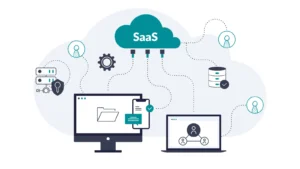Custom web application development is a technological tool that helps businesses accelerate growth by automating processes, improving efficiency, and optimizing operations. According to Statista, the global application development software market is projected to reach a revenue of $195.77 billion by 2025.
This staggering number represents the increasing demand for custom web application development in different industries. Businesses are constantly looking for ways to enhance their workflows using technological advancements like web application development, artificial intelligence, machine learning, etc. More and more industries are inclining towards cloud-based solutions and web applications. This not only makes the job easier for companies, but also for their corresponding target consumers.
In this guide, I’ll be covering the basic as well as advanced topics related to custom web development, including its types, benefits, web app vs. mobile app, the elements of web app development, the required tech stack, examples of popular web applications, and many more.
What is Web Application Development?
Web application development refers to the process of developing, testing, and deploying dynamic applications that web browsers can find online. Users can interact with web applications by installing them on devices through a web browser. Web browsers like Google Chrome, Mozilla, Firefox, etc., can be used to install these web apps. These web-based applications function using a combination of client-side and server-side programming, and are located on remote servers.
The entire process of developing a web app rests on these processes:
- Front-end Development: The development of the user interface (UI) and user experience (UX) is the front-end development process. It involves tools like HTML, CSS, and JavaScript to create menus, buttons, tabs, images, etc., that are visible on the screen.
- Back-end Development: It involves building the structure of the application, server-side logic, and database. In this process, the developer uses languages like Python, Java, or others to generate server-side logic to process information, store data, and fuel the app.
- Full-stack Development: This is the process that combines both front-end and back-end development.
Types of Custom Web Application Development
Custom web development is of different types to suit the different needs of various businesses. Some of the most popular types of custom web app development are:
- Customer Relationship Management (CRM) Systems: Businesses use the CRM tool to market their products and services, manage sales, and interact with their customers. It enhances customer experience by improving business-customer communication and boosting sales and marketing strategies.
- E-commerce Solutions: E-commerce platforms promote online sales of products and services with aspects like secure payment, order tracking, catalogue management, customer reviews, etc. It enhances the customer buying experience, resulting in an increase in your sales and expansion of customers.
- Content Management System (CMS): A CMS is highly popular today as it simplifies the entire content creation to distribution process. This platform can be used for interacting with your readers, developing/managing/changing content, and maintaining a dynamic website.
- Learning Management Systems (LMS): It is important for managing corporate training and educational initiatives. Training and educational institutions are utilizing LMS for tracking and delivering online courses and training materials to the learners. This simplifies the overall learning-teaching experience and smoothens the process.
- Project Management Tools: Project management tools are a must in modern workplaces to simplify workflows and improve team collaboration. These tools assist in tracking tasks, project deadlines, and project progress. Thus, making teams come together and complete projects in time and within budget.
There are many other notable applications of custom web app development in fields of inventory management, bookings and reservations, etc. After reading the above applications, I’m sure you can understand the significance of custom web application development in modern workflows and industries.
Why Do You Need Custom Web Application Development
Web application development is a flexible tool that changes with your evolving business needs. It assists with enhancing productivity, efficiency, streamlining workflows, managing production, and improving customer interaction to help your business scale in today’s competitive marketplace.
Customized web apps understand your specific requirements and leverage solutions corresponding to your domain and industry. These apps can automate time-consuming tasks, manage a large amount of data, and interact with existing systems.
Using these web apps, businesses can control the growth, interface, and performance of the apps. Also, they can adapt well to the changing needs of the business as they scale or decrease in size and function. Once deployed, they work with advancing technologies to satisfy the ever-changing needs of your customers by providing them with innovative solutions and interaction opportunities.
In comparison to off-the-shelf applications, custom web applications provide better security and data privacy. Organizations can secure sensitive data and comply with industry guidelines by utilizing their comprehensive security measures curated for your organization.
Benefits of Web Application Development
Web applications are the perfect tools for you if you want to efficiently manage business processes, improve customer experience, and dream of scaling. There are numerous benefits you can look forward to by deploying custom web applications in your organization:
Easy Accessibility
Custom web apps are easy to access from most browsers with a stable internet connection, making them available to a wide range of customers.
More Affordable
These web apps are cost-effective when compared to mobile or desktop applications in terms of development and management.
Security
Latest web applications offer curated security measures for your organization that provide data security, privacy, and compliance with industry standards.
Quick Updates
Web app updates are quick and simple to implement, thus making it easy for users to enjoy updated features and bug fixes.
Enhanced Efficiency
Web apps streamline workflows and business processes, making team collaboration simple, adherence to project deadlines easy, and also improve customer management, user experiences, etc.
Increased Revenue
By utilizing the varied features of custom web applications, businesses can improve their customer interaction by enhancing their experience, which results in greater revenues.
What are the Elements of Custom Web App Development?
A well-developed custom web application is based on the following elements:
- User experience
- Data management
- Business logic engine
- Security controls
- Workflow automation
- Analytics and reporting
Each of these elements plays a vital role in ensuring that your custom web application is functional, user-friendly, scalable, and efficient.
What are the Steps to Create a Custom Web Application?
Understanding Requirements
Before developing a web application, it is advisable to go through the requirements and your expectations from it. Start by conducting comprehensive research on functional needs, customer expectations, competitors, and market analysis.
Analyzing and Planning
After completing your research, start by planning and analyzing the requirements. Always consider these points in your plan:
- What are the goals?
- The look of your MVP and what should be next.
- Architecture specification.
- Tech stack that includes framework, tools, etc.
- Decide on its features, workflows, and functionalities.
Design
The design part includes wireframe generation, UI design, and UX formats. This phase should involve keeping the user experience in mind. Design an interface that is intuitive and easy to navigate.
Development
The most vital step, when developers bring your set functionalities and design to life. This step includes backend and frontend developments, databases and APIs integration, and incorporating scalability and security measures.
Testing
During this process, the developed software is tested for functionality for both business employees and users. Before uploading it to the hosting firm, any changes to the software must be manually tested by software developers (mostly online servers).
Implementation & Maintenance
Implementation involves server setup, database configuration, and getting every element working smoothly. After deployment, regular updates and maintenance keep the application healthy and smooth.
Tech Stack For Web Application Development
To choose a suitable tech stack for custom web application development, always keep the business domain and needs in mind. Here are the standard technology stacks required for custom web app development.
| Components | Technologies |
| Front-end Frameworks | React.js, Angular, Vue.js |
| Back-end Languages | Python, Java, Ruby, Node.js, PHP |
| Back-end Frameworks | Django, Spring Boot, Ruby on Rails, Express.js, Laravel |
| Databases (Relational) | MySQL, PostgreSQL, MS SQL |
| Databases (NoSQL) | MongoDB, CouchDB |
| Middleware & APIs | RESTful APIs, GraphQL |
Top 6 Examples of Web Application Development
1. Airbnb
With the Airbnb web app, you can search for houses for rent, and hosts can list their houses/ properties for rent to visitors. The host submits their houses by providing a description and photos, and the customers can choose and pay via the app to book a stay.
2. Google Doc
It is a widely used online word processor that lets users generate, collaborate, and share documents online. It also allows integration of other applications and extensions as needed.
3. Salesforce
It is a prime example of a well-designed and highly performing web app. It offers an exceptional toolkit and a smartly designed user interface that is appreciated by all levels of professionals.
4. Facebook
A father of social media apps, Facebook offers a web application along with a mobile application. It consists of a newsfeed, profiles, messaging, friend list, and notifications. It also has a market to buy/sell products, a stories section, and many other exclusive features.
5. Netflix
Netflix is a popular OTT platform where you can watch movies and series on its web application, alongside its mobile app. While using the app, you can search for movies/ series, play and pause the content, and choose preferred audio and subtitles. You can also create your profile, manage other users (added to your profile), wishlist content, and view what’s new and upcoming.
6. Slack
Slack became hugely successful as a mode of communication among teams during the COVID pandemic. It has features like chat with teams of the same organization, one-on-one or group chatting, file sharing, app integration, and others.
Successful Web Development Companies in 2025
In this section, I will give you examples of top web development companies globally, their offerings, and the brands they have helped to scale:
1. Brainhub
They are a well-known name for custom web application development. They focus on business-specific development, quick and trustworthy software delivery, precise risk management, working on a budget, and on-time delivery with no compromise on quality.
Services: Custom web app development, mobile app development, UI/UX, desktop development, legacy modernization, and others.
Clients: PWC, National Geographic, Venture Harbour, Medicover GO, etc.
2. STX Next
With over 19 years of experience, they are an IT consulting firm offering AI-driven software solutions. Their services help to transform businesses through analyzing large datasets, detecting patterns, and making decisions based on that.
Services: AI and data solutions, cloud and technology consulting, and product design.
Clients: Canon, Decathlon, Mastercard, among others.
3. CheesecakeLabs
They expertly develop and design web and mobile applications that enable their clients to build scalable and efficient solutions. Founded in 2013 in San Francisco, they are known to provide comprehensive services, from planning, developing, designing, to deployment.
Services: Mobile app development, custom website development services, web design, UX/UI design, and web solutions.
Clients: Skyroam, Lockitron, Singularity University.
There are many other popular names in the industry of custom web application development, like 10Clouds, EL Passion, and Xmartlabs. You can check out their websites individually to understand their offerings in detail, about the company, team, etc.
2025 Trends in Custom Web Application Development
With the changing global technological environment, you can expect some innovative trends in the custom web application development arena, too. Here are some of the latest trends that you can look forward to:
- Multi-experience Development: Building applications that can function across web, mobile, and other platforms with one build.
- Low Code/ No Code (LCNC) Platforms: To enable business teams to develop web applications without any help from developers.
- Natural Language & Voice Interfaces: Enhancing user experience by integrating chat-based UIs and voice assistants into web applications.
- AI-driven Development: Utilize the power of AI in development to auto-create code logic, recommend workflows, and predict bottlenecks.
- Privacy-first Framework: In-built security protocols, consent mechanisms, and compliance tracing.
- Composable Applications: Built from reusable components that can be used across numerous applications for quicker scaling.
Conclusion: The Future of Web Application Development
With the advent of newer technological trends like artificial intelligence (AI) and machine learning (ML), Internet of Things (IoT), serverless computing, virtual, and augmented reality, the future of web application development cannot be any better!
Today’s businesses and users have evolving needs depending on both technological and social trends. To adhere to these developments, businesses are using custom web application development to power their growth through efficient workflow, customer management, and faster project delivery.
By using strategic planning, creating a framework, testing usability, and maintaining custom web applications, you can take your business to higher levels of productivity and innovation.
Related: How Blockchain Locks Data: A Beginner’s Guide
Related: What is iPaaS & SaaS? Key Benefits, Use Cases, and Differences







